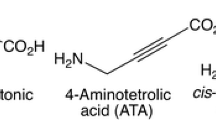Summary
5-HT3 binding sites with high affinity (Kd = 0.3 – 1.0 nM) for [3H]zacopride have been studied in brain, vagus nerve, enteric neurons, and PC12 cells. A novel 5-HT3 binding site in guinea pig small bowel exhibits decreased affinity for zacopride and other 5-HT3 antagonists but a similar rank order of potency to that of 5-HT3 binding sites in rabbit bowel and vagus nerve. The (S)-enantiomer of zacopride exhibits a 10–40 fold greater affinity for 5-HT3 binding sites than its (R)-enantiomer, a ratio which correlates with their antimetic potency. However (R)-zacopride is > 1000 fold more potent that the (S)-enantiomer as an anxiolytic. Together with our ligand binding and radioautographic studies, this suggests that some of the therapeutic effects of the R isomer may not be due to binding at 5-HT3 receptors. [3H](S)-zacopride also labelled a 5-HT3 binding site which is expressed in PC12 cells cultured with nerve growth factor. Finally, a 5-HT3 binding site was solubilized from rabbit small bowel muscularis membranes, labelled with [3H](S)-zacopride and found to retain the binding properties of the membrane-bound form.
Access this chapter
Tax calculation will be finalised at checkout
Purchases are for personal use only
Preview
Unable to display preview. Download preview PDF.
Similar content being viewed by others
References
Alphin, R. S., Smith, W. L., Jackson, C. B., Droppleman, D. A., and Sancilio, L. F. (1986). Zacopride (AHR I1190B): A unique and potent gastrointestinal prokinetic and antiemetic agent in laboratory animals. Dig. Dis. Sci. 31: 4825.
Barnes, J. M., Barnes, N. M., Costal], B., Domeney, A. M., Kelly, M. E., and Naylor, R. J. (1990a). Influence of 5-HT3 antagonists on limbic cortical circuitry. Second IUPHAR Satellite Meeting on Serotonin. abs. P102.
Barnes, J. M., Barnes, N. M., Costall, B., Naylor, I. L., Naylor, R. J., and Rudd, J. A. (1990b). Topographical distribution of 5-HT3 receptor recognition sites in the ferret brain stem. Naunyn-Schmiedeberg’s. Arch. Pharmacol. 342: 17–21.
Barnes, J. M., Barnes, N. M., Costall, B., Domeney, A. M., Kelly, M. E., and Naylor, R. J. (1990c). Profile of the stereoisomers of zacopride as 5-HT3 receptor antagonists. Second IUPHAR Satellite Meeting on Serotonin. abs. PI17.
Barnes, N. M., Costal], B., and Naylor, R. J. (1988). [3H]Zacopride: A ligand for the identification of 5-HT3 recognition sites. J. Pharm. Pharmacol. 40: 548–551.
Bockaert, I., Sebben, M., and Dumuis, A. (1990). Interrelationship between the interactions of 5-HT and benzamide derivatives on 5-HT4 receptors in brain. Second IUPHAR Satellite Meeting on Serotonin. abs. P66.
Cheng, Y. C., and Prusoff, W. H. (1973). Relationship between the inhibitor constant (Ki) and the concentration of inhibitor which causes 50% inhibition (IC50) of an enzymatic reaction. Biochem. Pharmacol. 22: 3099–3108.
Clarke, D. E., and Craig, D. A. (1990). Pharmacological properties of the putative 5-HT4 receptor in guinea pig ileum. IUPHAR Satellite Symposium on Serotonin. abs P67.
Cohen, M. L., Bloomquist, W., Gidda, J. S., and Lacefield, W. (1989). Comparison of the 5-HT3 receptor antagonist properties of ICS 205–930, GR 38032F, and zacopride. J. Pharmacol. Exp. Ther. 248: 197–201.
Costall, B., Domeney, A. M., Gerrard, P. A., Kelly, M. E., and Naylor, R. J. (1988). Zacopride: anxiolytic profile in rodent and primate models of anxiety. J. Pharm. Pharmacol. 40: 302–305.
Demain, I., and Gripshover, D. F. (1989). Enantiomeric purity determination of 3-aminoquinuclidine by diastereomeric derivatization and high performance liquid chromotographic separation. J. Chromatogr. 466: 415–420.
Dumuis, A., Sebben, M., and Bockaert, J. (1989). The gastrointestinal prokinetic benzamide derivatives are agonists at the non-classical 5-HT receptor (5-HT4) positively coupled to adenylate cyclase in neurone. Naunyn-Schmiedeberg’s. Arch. Pharmacol. 340: 403–409.
Eglen, R. M., Swank, S. R., Walsh, L. K. M., and Whiting, R. L. (1990). Characterization of 5-HT3 and “atypical” 5-HT receptors mediating guinea-pig ilea] contractions in vitro. Br. J. Pharmacol. 101: 513–520.
Gershon, M. D., Wade, P., Kirchgesser, A., Florica-Howells, E., and Tamir, H. (1990). 5-HTIp receptors in the bowel: G protein coupling, localization, and function. Second IUPHAR Satellite Meeting on Serotonin. abs. P40.
Gordon, J. C., Barefoot, D. S., Sarbin, N. S., and Pinkus, L. M. (1989). [3H]zacopride binding to 5-hydroxytryptamine3 sites on partially purified rabbit enteric neuronal membranes. J. Pharmacol. Exp. Ther. 251: 962–968.
Gordon, J. C., and Rowland, H. (1990). Nerve Growth Factor induces 5-HT3 recognition sites in rat pheochromocytoma (PC12) cells. Life Sci. 46: 1435–1442.
Gordon, J. C., Sarbin, N. S., Barefoot, D. S., and Pinkus, L. M. (1990). Solubilization of a 5-HT3 receptor from rabbit small bowel muscularis membranes. Eur. J. Pharmacol. (Mol. Pharmacol. Sect. ). 188: 313–319.
Hoyer, D., and Neijit, H. C. (1988). Identification of serotonin 5-HT3 recognition sites in membranes of N1E-115 neuroblastoma cells by radioligand binding. Mol. Pharmacol. 33: 303–309.
Hoyer, D., Waeber, C., Karpf, A., Neijt, H., and Palacios, J. M. (1989). [3H]ICS 205–930 labels 5-HT3 recognition sites in membranes of cat and rabbit vagus nerve and superior cervical ganglion. Naunyn-Schmiedeberg’s. Arch. Pharmacol. 340: 396–402.
Kilpatrick, G. J., Butler, A., Hagan, R. M., Jones, B. J., and Tyers, M. B. (1990). [3H]GR 67330, a very high affinity ligant for 5-HT3 receptors. Naunyn-Schmiedeberg’s. Arch. Pharmacol. 342: 22–30.
McKernan, R. M., Biggs, C. S., Gillard, N., Quirk, K., and Ragan, C. I. (1990a). Molecular size of the 5-HT, receptor solubilized from NCB 20 cells. J. Neurochem. 269: 623–628. McKernan, R. M., Quirk, K., Jackson, R. G., and Ragan, C. I. (1990b). Solubilization of the 5-hydroxytryptamine, receptor from pooled rat cortical and hippocampal membranes. J. Neurochem. 54: 924–930.
Pinkus, L. M., Sarbin, N. S., Barefoot, D. S., and Gordon, J. C. (1989). Association of [3H]zacoprode binding to 5-HT, binding sites. Eur. J. Pharmacol. 168: 355–362.
Pinkus, L. M., Sarbin, N. S., Gordon, J. C., and Munson, H. R. (1990). Antagonism of [3H]zacopride binding to 5-HT3 recognition sites by its (R) and (S) enantiomers. Eur. J. Pharmacol. 179: 231–235.
Robertson, D. W., Cohen, M. L., Krushinski, J. H., Wong, D. T., Parli, C. J., and Gidda, J. S. (1990). LY 191617, A 5-HT3 receptor antagonist which does not cross the blood brain barrier. Second IUPHAR Satellite Meeting on Serotonin. abs. P111.
Sancilio, L. F., Pinkus, L. M., Jackson, C. B., and Munson, H. R., Jr. (1990). Contraction of guinea pig gastric smooth muscle cells by 5-HT3 antagonists and agonists. Eur. J. Pharmacol. submitted for publication.
Tougas, G., Woskowska, Z., Fox, J. E. T., and Daniel, E. E. (1990). Acid-induced pyroduodenal motor response: role of 5-HT3 receptors. Second IUPHAR Satellite Meeting on Serotonin. abs. P76.
Wang, C., and Smith, R. L. (1975). Lowry determination of protein in the presence of Triton X-100. Anal. Biochem. 63: 414–420.
Waeber, C., Pinkus, L. M., and Palacios, J. M. (1990). The (S)-isomer of [3H]zacopride labels 5-HT, receptors with high affinity in rat brain. Eur. J. Pharmacol. 181: 283–287.
Young, R., and Johnson, D. (1989). Effects of +, R(+), and S(—)-zacopride in the mouse light/dark exploratory model. Lorenzini Fdn. Symp.: 179, “Serotonin from Cell Biology to Pharmacology and Therapeutics”. abs. P182.
Author information
Authors and Affiliations
Editor information
Editors and Affiliations
Rights and permissions
Copyright information
© 1991 Birkhäuser Verlag Basel/Switzerland
About this chapter
Cite this chapter
Pinkus, L.M., Gordon, J.C. (1991). Utilization of Zacopride and its R- and S-Enantiomers in Studies of 5-HT3 Receptor “Subtypes”. In: Fozard, J.R., Saxena, P.R. (eds) Serotonin: Molecular Biology, Receptors and Functional Effects. Birkhäuser Basel. https://doi.org/10.1007/978-3-0348-7259-1_44
Download citation
DOI: https://doi.org/10.1007/978-3-0348-7259-1_44
Publisher Name: Birkhäuser Basel
Print ISBN: 978-3-0348-7261-4
Online ISBN: 978-3-0348-7259-1
eBook Packages: Springer Book Archive




